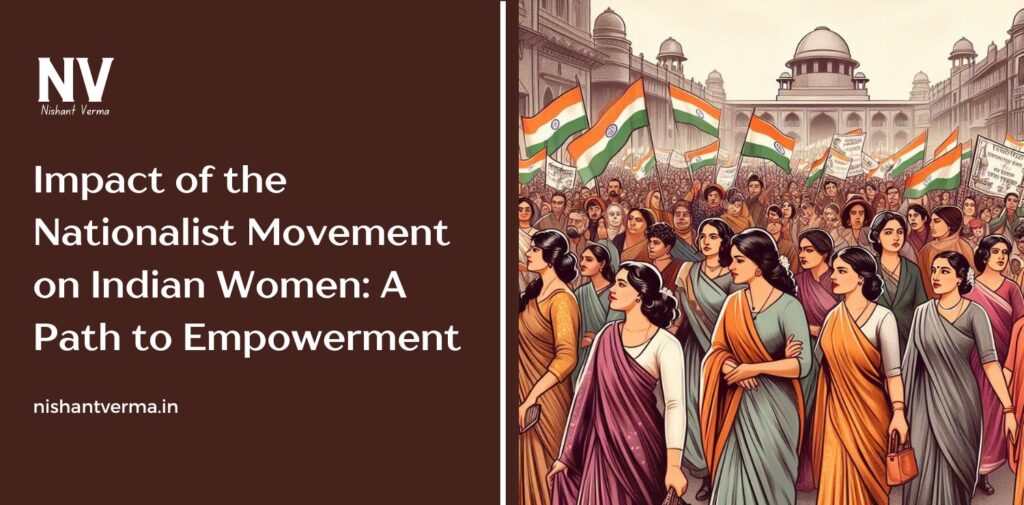The Indian nationalist movement, which fought against British colonial rule, was not only a political struggle but also a social revolution that impacted every aspect of Indian society. While much of the focus during this period was on male leaders and freedom fighters, the role of Indian women in the nationalist movement is just as significant and transformative. The nationalist movement provided Indian women with a platform to break free from traditional roles and stereotypes and to actively participate in the fight for India’s independence.
This article explores the profound impact of the nationalist movement on Indian women, how it led to their empowerment, and how their involvement in the freedom struggle changed their status in society forever.
Breaking Traditional Boundaries
Before the rise of the nationalist movement, Indian women were often confined to the domestic sphere. Their roles were primarily centered around home-making, child-rearing, and managing household chores. Women’s education and participation in public life were limited, and they were largely excluded from political and social activities. The general view in society was that women should remain within the boundaries of their homes and avoid public affairs.
However, the nationalist movement broke down many of these barriers. As the struggle for independence gained momentum, women began to step outside the confines of their homes and participate in social, political, and even military activities. The involvement of women in the nationalist movement was revolutionary and marked a turning point in the history of women’s rights in India.

Women as Leaders and Activists
Several prominent women played an active and leadership role in the nationalist movement, inspiring countless others to join the struggle for independence. Some of these women became symbols of courage and strength, challenging both British rule and patriarchal norms that restricted women’s roles in society.
Sarojini Naidu
One of the most famous figures in this regard is Sarojini Naidu, also known as the “Nightingale of India.” Sarojini Naidu was not just a poet and an advocate for education but also an active participant in the freedom movement. She became the first woman to become the president of the Indian National Congress (INC) and was one of the leading voices in the civil disobedience movement.
Sarojini Naidu’s leadership showed the world that women were not just passive participants but could take charge of political leadership. Her eloquence and ability to mobilize people helped increase women’s involvement in political activities, and she remains an inspiration for women leaders to this day.
Kasturba Gandhi
Kasturba Gandhi, the wife of Mahatma Gandhi, also played a significant role in the movement, especially in leading women’s participation in protests and social reform campaigns. She was instrumental in organizing women during the Salt March and played a crucial role in spreading Gandhian principles of non-violence and civil disobedience among women across India.
Kasturba’s role was crucial because she showed that the fight for freedom was not just about men leading protests but also about women becoming active participants in shaping the future of the country.
Begum Hazrat Mahal
Another important figure was Begum Hazrat Mahal, the wife of the exiled Nawab of Oudh. She played a leading role in the rebellion of 1857 (often considered the First War of Indian Independence), leading the revolt against the British in Lucknow. Her bravery and leadership in battle made her one of the first women to take up arms in the fight against British rule.
Her contribution, though often overshadowed by larger historical events, was a key moment in women’s involvement in the freedom struggle.

Mass Participation of Women
The nationalist movement also witnessed a mass participation of women, not just as leaders but also as foot soldiers in various campaigns. Women from all walks of life—rich and poor, educated and uneducated, urban and rural—joined the struggle for freedom in a variety of ways.
Women participated in protests, marches, boycotts of British goods, and even in prison campaigns. The Non-Cooperation Movement and Salt March, led by Mahatma Gandhi, became important platforms for women to actively participate in the national movement. Women participated in large numbers in these movements, defying the social expectations placed upon them.
In the Salt March of 1930, for example, many women walked alongside men in protest against the British monopoly on salt. The sight of women joining in such large-scale protests was unprecedented and marked a shift in the public perception of women’s role in society.
Role in Social and Cultural Reform
Apart from the political and military participation in the freedom struggle, women also played a critical role in social reform movements during the nationalist period. The nationalist leaders recognized that the social reform of women was essential to the overall progress of the nation. Several reformist leaders, such as Ishwar Chandra Vidyasagar and Raja Ram Mohan Roy, worked to improve women’s rights and reduce social inequalities.
Women like Kamini Roy and Subhadra Kumari Chauhan used their poetry and writing to address issues related to women’s education, child marriage, and widow remarriage. They advocated for women’s rights and encouraged other women to participate in the fight for freedom by focusing on their social rights.
One of the most significant social changes during this time was the Widow Remarriage Act, which allowed widows to remarry, a progressive law that was strongly supported by many nationalist leaders. Women’s education, which was once a rarity, began to gain prominence during the nationalist movement. Female leaders like Sarala Devi Chaudhurani and Begum Roquiah Sakhawat Hossain promoted education for women, urging them to stand up for their rights.

Women in the Armed Struggle
The nationalist movement also saw women contributing to the armed struggle. Women played important roles as soldiers, couriers, and spies during the Quit India Movement of 1942 and other resistance activities. Many women joined underground movements, risking their lives to support the struggle for independence.
One notable example is Rani Lakshmibai of Jhansi, who led her troops in battle against the British during the 1857 uprising. Though this rebellion happened before the rise of major nationalist movements, her courage and leadership inspired later generations of women freedom fighters.
During the later years of the freedom struggle, women like Aruna Asaf Ali, who hoisted the Indian flag at the Gowalia Tank in Bombay during the Quit India Movement, became national heroes. Her actions demonstrated that women were not only willing to protest but also willing to fight for independence in any way possible.
Changing Roles and New Opportunities
The nationalist movement opened new opportunities for women. With more and more women entering the political and social spheres, women began to be seen as active agents of change rather than passive followers. They contributed to all aspects of the movement—from leadership to organizing grassroots support to carrying out covert operations.
The participation of women in the nationalist movement also helped to change attitudes towards women’s education and employment. More women began to attend schools, colleges, and universities, and the idea of women working outside the home became increasingly accepted. This shift was crucial in laying the foundation for the feminist movements that would follow after India’s independence.
Conclusion: the Nationalist Movement
The impact of the nationalist movement on Indian women was profound and far-reaching. Through their involvement in the freedom struggle, women not only contributed to India’s independence but also transformed their own social, political, and cultural roles. The movement gave women the opportunity to step out of traditional gender roles and claim their place in India’s future.
Women like Sarojini Naidu, Kasturba Gandhi, and Aruna Asaf Ali became symbols of courage and inspiration for future generations. They proved that women could take part in the public and political spheres, not just as supporters but as leaders. The nationalist movement also sparked broader changes in women’s rights, such as improved access to education and the ability to participate in the workforce, which continues to shape modern India.
In conclusion, the nationalist movement played a pivotal role in empowering women and advancing gender equality. It was not just about achieving political freedom but also about freeing women from the constraints of tradition and allowing them to shape the future of the nation. The struggle for independence gave Indian women a voice, a vision, and a path to equality, which has echoed in the social movements and progress India continues to see today.




